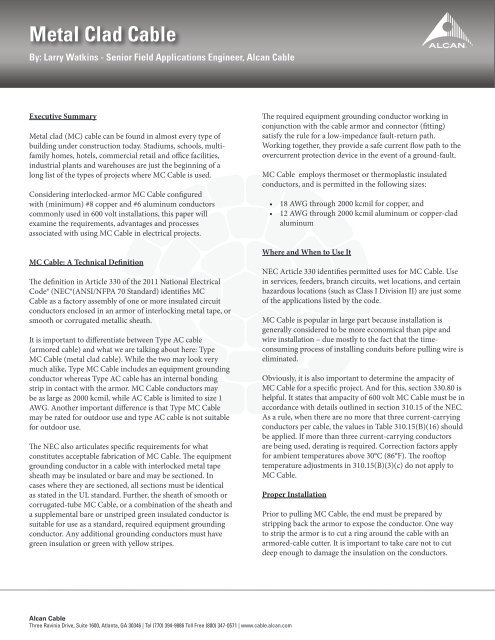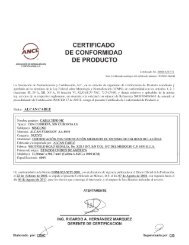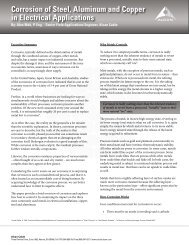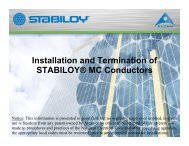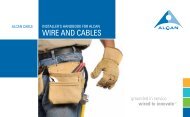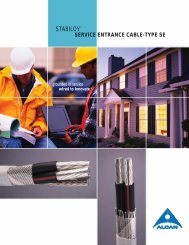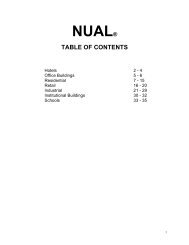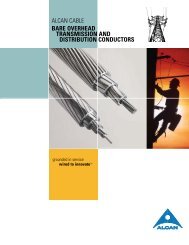Metal Clad Cable - Alcan - Rio Tinto Alcan
Metal Clad Cable - Alcan - Rio Tinto Alcan
Metal Clad Cable - Alcan - Rio Tinto Alcan
Create successful ePaper yourself
Turn your PDF publications into a flip-book with our unique Google optimized e-Paper software.
<strong>Metal</strong> <strong>Clad</strong> <strong>Cable</strong><br />
By: Larry Watkins - Senior Field Applications Engineer, <strong>Alcan</strong> <strong>Cable</strong><br />
Executive Summary<br />
<strong>Metal</strong> clad (MC) cable can be found in almost every type of<br />
building under construction today. Stadiums, schools, multifamily<br />
homes, hotels, commercial retail and office facilities,<br />
industrial plants and warehouses are just the beginning of a<br />
long list of the types of projects where MC <strong>Cable</strong> is used.<br />
Considering interlocked-armor MC <strong>Cable</strong> configured<br />
with (minimum) #8 copper and #6 aluminum conductors<br />
commonly used in 600 volt installations, this paper will<br />
examine the requirements, advantages and processes<br />
associated with using MC <strong>Cable</strong> in electrical projects.<br />
MC <strong>Cable</strong>: A Technical Definition<br />
The definition in Article 330 of the 2011 National Electrical<br />
Code® (NEC®(ANSI/NFPA 70 Standard) identifies MC<br />
<strong>Cable</strong> as a factory assembly of one or more insulated circuit<br />
conductors enclosed in an armor of interlocking metal tape, or<br />
smooth or corrugated metallic sheath.<br />
It is important to differentiate between Type AC cable<br />
(armored cable) and what we are talking about here: Type<br />
MC <strong>Cable</strong> (metal clad cable). While the two may look very<br />
much alike, Type MC <strong>Cable</strong> includes an equipment grounding<br />
conductor whereas Type AC cable has an internal bonding<br />
strip in contact with the armor. MC <strong>Cable</strong> conductors may<br />
be as large as 2000 kcmil, while AC <strong>Cable</strong> is limited to size 1<br />
AWG. Another important difference is that Type MC <strong>Cable</strong><br />
may be rated for outdoor use and type AC cable is not suitable<br />
for outdoor use.<br />
The NEC also articulates specific requirements for what<br />
constitutes acceptable fabrication of MC <strong>Cable</strong>. The equipment<br />
grounding conductor in a cable with interlocked metal tape<br />
sheath may be insulated or bare and may be sectioned. In<br />
cases where they are sectioned, all sections must be identical<br />
as stated in the UL standard. Further, the sheath of smooth or<br />
corrugated-tube MC <strong>Cable</strong>, or a combination of the sheath and<br />
a supplemental bare or unstriped green insulated conductor is<br />
suitable for use as a standard, required equipment grounding<br />
conductor. Any additional grounding conductors must have<br />
green insulation or green with yellow stripes.<br />
<strong>Alcan</strong> <strong>Cable</strong><br />
Three Ravinia Drive, Suite 1600, Atlanta, GA 30346 | Tel (770) 394-9886 Toll Free (800) 347-0571 | www.cable.alcan.com<br />
The required equipment grounding conductor working in<br />
conjunction with the cable armor and connector (fitting)<br />
satisfy the rule for a low-impedance fault-return path.<br />
Working together, they provide a safe current flow path to the<br />
overcurrent protection device in the event of a ground-fault.<br />
MC <strong>Cable</strong> employs thermoset or thermoplastic insulated<br />
conductors, and is permitted in the following sizes:<br />
• 18 AWG through 2000 kcmil for copper, and<br />
• 12 AWG through 2000 kcmil aluminum or copper-clad<br />
aluminum<br />
Where and When to Use It<br />
NEC Article 330 identifies permitted uses for MC <strong>Cable</strong>. Use<br />
in services, feeders, branch circuits, wet locations, and certain<br />
hazardous locations (such as Class I Division II) are just some<br />
of the applications listed by the code.<br />
MC <strong>Cable</strong> is popular in large part because installation is<br />
generally considered to be more economical than pipe and<br />
wire installation – due mostly to the fact that the timeconsuming<br />
process of installing conduits before pulling wire is<br />
eliminated.<br />
Obviously, it is also important to determine the ampacity of<br />
MC <strong>Cable</strong> for a specific project. And for this, section 330.80 is<br />
helpful. It states that ampacity of 600 volt MC <strong>Cable</strong> must be in<br />
accordance with details outlined in section 310.15 of the NEC.<br />
As a rule, when there are no more that three current-carrying<br />
conductors per cable, the values in Table 310.15(B)(16) should<br />
be applied. If more than three current-carrying conductors<br />
are being used, derating is required. Correction factors apply<br />
for ambient temperatures above 30°C (86°F). The rooftop<br />
temperature adjustments in 310.15(B)(3)(c) do not apply to<br />
MC <strong>Cable</strong>.<br />
Proper Installation<br />
Prior to pulling MC <strong>Cable</strong>, the end must be prepared by<br />
stripping back the armor to expose the conductor. One way<br />
to strip the armor is to cut a ring around the cable with an<br />
armored-cable cutter. It is important to take care not to cut<br />
deep enough to damage the insulation on the conductors.<br />
®
Another commonly used method is to cut two adjacent ribs of<br />
the armor with a rotary cutter or a hacksaw in order to slide<br />
the armor off.<br />
After the conductor is exposed, a basket grip is placed over<br />
the conductor assembly and then the conductors, armor and<br />
basket are taped together. It is important to remember that,<br />
when pulling, force is to be applied to the conductors and not<br />
the armor.<br />
Longer cable pull routes should be prepared by placing sheave<br />
wheels or pulleys at distances that will ensure the cable will<br />
pull properly and not be damaged in the process. Wheels or<br />
pulleys are not required for shorter pulls but smooth surfaces<br />
are. Pulling MC <strong>Cable</strong> over hard edges such as angle iron can<br />
result in damage to the armor.<br />
For reassurance, UL 1569 metal-clad cable-testing<br />
requirements include a tension test of the armor. This test<br />
involves a 150 lb weight hanging from the armor for five<br />
minutes. To pass muster, the armor must not separate enough<br />
to expose the cable interior.<br />
Proper cable support is also essential, and requirements<br />
are detailed in NEC Section 330.30. MC <strong>Cable</strong> must be<br />
supported and secured at intervals not exceeding 6 ft. (1.83 m).<br />
Appropriate supports include struts, trapezes, racks and cable<br />
trays. Generally, the same support systems used with metal<br />
conduit are used for MC <strong>Cable</strong>, with one notable difference:<br />
MC <strong>Cable</strong> installations require support at a maximum distance<br />
of 6 ft – not 10 ft as is required for most conduit installations.<br />
MC <strong>Cable</strong> can also be secured by the same assortment of<br />
clamps used to support conduit.<br />
Also with regard to appropriate support mechanisms, MC<br />
<strong>Cable</strong> enjoys some leeway in situations where support<br />
structures are not practical. NEC Section 330.30(D) states,<br />
“Type MC <strong>Cable</strong> shall be permitted to be unsupported where<br />
the cable is "...fished between access points through concealed<br />
spaces in finished buildings or structures and supporting is<br />
impractical..." It is also allowed to be unsupported for lengths up<br />
to six feet when used for luminaires”.<br />
Although cables are not specifically required to be supported<br />
according to the requirements in Table 300.19(A), it might<br />
be desirable to relieve the vertical weight of the conductors<br />
according to the distances in the table. Some methods might<br />
include clamps designed for compressing the armor and<br />
the subassembly, bending the cable to provide a horizontal<br />
component mid-run, or some other method. Section 300.19<br />
requires that one cable support must be provided at the top of<br />
the vertical raceway or as close to the top as is practical, and<br />
this is a good idea for MC <strong>Cable</strong> installations as well.<br />
<strong>Alcan</strong> <strong>Cable</strong><br />
Three Ravinia Drive, Suite 1600, Atlanta, GA 30346 | Tel (770) 394-9886 Toll Free (800) 347-0571 | www.cable.alcan.com<br />
One method of supporting and securing vertically run multiconductor<br />
MC <strong>Cable</strong> is to install cables with 90-degree offsets<br />
at a minimum horizontal distance of two cable diameters.<br />
Here, it is important to remember that interlocked armor MC<br />
<strong>Cable</strong> bends must not exceed seven times the diameter of the<br />
cable.<br />
Another method is to terminate the conductors, perhaps in a<br />
junction box, and start a new section of cable that continues<br />
on the vertical run. There are also clamps that are available<br />
to compress the armor and conductors to relieve the stress at<br />
appropriate intervals.<br />
As noted, weight of the cable is an important factor here, and<br />
this is apparent in the difference in support requirements<br />
for copper conductors and aluminum conductors. Based on<br />
the same principle – the influence of gravity – the tightness<br />
of the fit of the armor to the conductors is also a significant<br />
consideration. In accordance with UL 1569 requirements,<br />
cables containing 4 AWG or larger conductors must pass<br />
a test in which a conductor within a vertically suspended<br />
10 ft sample cable is attached to a 30 lb weight. To meet<br />
requirements, the conductor cannot displace more than onehalf<br />
inch over a period of one minute.<br />
One significant advantage of MC <strong>Cable</strong> is its versatility in<br />
terms of installation flexibility. MC <strong>Cable</strong> installations are<br />
easily identifiable by their lack of pull boxes. While conductors<br />
pulled in conduit are limited to no more than the equivalent<br />
of four quarter turns (360 degrees) between pull points,<br />
MC <strong>Cable</strong> has no restrictions on the number of bends. As<br />
mentioned previously, the bending requirement for interlocked<br />
armor MC <strong>Cable</strong> is “seven times the external diameter of the<br />
metallic sheath” as stated in Section 330.24(B) of the NEC.<br />
If you have a two-inch diameter MC <strong>Cable</strong> the radius of the<br />
curve of the inner edge of the bend shall not be less than 14<br />
inches.<br />
Having planned, pulled, supported and secured, it’s time to<br />
terminate. Using the same process described earlier to remove<br />
MC <strong>Cable</strong> armor, remember to be careful not to damage the<br />
insulation on the conductors in preparation for termination.<br />
Next, we must ensure the selection of appropriate fittings.<br />
A primary function of fittings is to provide a solid mechanical<br />
connection between the cable and the enclosure in order to<br />
ensure the armor is properly bonded. Section 330.40 requires<br />
that fittings used to connect MC <strong>Cable</strong> to boxes, cabinets, or<br />
other equipment shall be listed and identified for such use. A<br />
reason for this is that one of the major differences between<br />
fittings for Type AC cable and Type MC cable is that AC<br />
cable (as per Section 320.40) requires insulating (anti-short)<br />
bushings or an equivalent form of protection.<br />
®
When terminating MC <strong>Cable</strong>, it is important to ensure there<br />
are no sharp edges in the fitting or armor that could damage<br />
the insulation on the conductors. The end of the armor should<br />
be squared to provide a flush fit with the end stop of the fitting.<br />
In order to select the correctly sized fitting, it is important to<br />
know the dimensions of the MC <strong>Cable</strong> conductor assembly, the<br />
armor diameter, the fitting dimensions of the throat opening<br />
for the conductors and the clamping range for securing the<br />
MC <strong>Cable</strong> armor in the fitting. MC <strong>Cable</strong> has a polyester or<br />
paper wrap around the conductor assembly. Fittings listed for<br />
MC <strong>Cable</strong> by design may or may not include an insulating<br />
bushing. It is prudent for installers to note the instructions<br />
that accompany the fitting, and for them to be aware of<br />
whether or not a bushing is included. When manufacturers<br />
list fittings as being usable with both Type AC and Type MC<br />
<strong>Cable</strong>, this typically means a bushing is included with the<br />
fitting. In these cases, the installer should verify with the<br />
fitting manufacturer if the fitting was listed with or without the<br />
bushing for Type MC <strong>Cable</strong>. It never hurts to check with the<br />
fitting manufacturer and have a quick discussion around the<br />
suitability of using their fitting.<br />
Proper Sizing<br />
Section 330.108 states, “Where Type MC <strong>Cable</strong> is used to<br />
provide an equipment grounding conductor, it shall comply<br />
with 250.118(10) and 250.122.” MC <strong>Cable</strong> comes with an<br />
insulated or bare equipment ground that is sized to protect<br />
the conductors in that cable. The standard equipment ground<br />
supplied for the particular MC <strong>Cable</strong> is not, in most cases,<br />
properly sized for multiple parallel runs of cable. Section<br />
250.122 (F) addresses the requirement for properly sizing the<br />
equipment ground conductors for cables run in parallel.<br />
Table 250.122 lists the minimum equipment ground size for<br />
the overcurrent device rating. Upon request, manufacturers<br />
of MC <strong>Cable</strong> do provide cables with larger equipment ground<br />
conductors. <strong>Alcan</strong> <strong>Cable</strong> provides stock sizes suitable for use<br />
with a range of overcurrent devices.<br />
Post-Installation: Identifying Type and Size<br />
The installation and inspection of electrical components within<br />
an electrical system are critical to the performance of the<br />
system. When examining MC <strong>Cable</strong> installations, inspectors<br />
should note how the cables are handled, pulling setup, support<br />
methods, armor stripping techniques, locations installed,<br />
proper bending, and the use of appropriately sized, listed MC<br />
<strong>Cable</strong> fittings. It is important to observe everything within<br />
the context of the NEC, but to also pay close attention to local<br />
amendments. It always makes sense to check in with the local<br />
authority having jurisdiction.<br />
As an inspector, it can be very difficult to identify conductor<br />
type and size after installation. With conduit-and-conductor<br />
installations you must look for cut-off conductor pieces or<br />
conductor remaining on reels. The same techniques are used<br />
with MC <strong>Cable</strong>. MC <strong>Cable</strong> information such as cable and<br />
conductor type, size and voltage is shown either on the marker<br />
tape included under the armor or on the conductors.<br />
Conclusion<br />
Type metal clad cable offers an economical, versatile approach<br />
to a wide array of construction projects. Distinguished from<br />
armored cable because it includes a grounding wire and can<br />
be used in outdoor applications, it also offers significant<br />
installation efficiency advantages over conductor-and-conduit<br />
applications – especially in terms of labor outlay. No conduits<br />
and no pull-boxes equate to easier installs with fewer materials<br />
in less time. All of these factors add up to an excellent option<br />
in a world that is increasingly looking for financial and<br />
resource efficiency.<br />
References<br />
<strong>Alcan</strong> <strong>Cable</strong><br />
Three Ravinia Drive, Suite 1600, Atlanta, GA 30346 | Tel (770) 394-9886 Toll Free (800) 347-0571 | www.cable.alcan.com<br />
ACWP-0003<br />
7/2011<br />
©2011 <strong>Alcan</strong> <strong>Cable</strong>. is a registered trademark of <strong>Rio</strong> <strong>Tinto</strong> <strong>Alcan</strong> Inc. All rights reserved.<br />
®<br />
©2011 NFPA. National Electrical Code and NEC are registered trademarks of NFPA. All rights reserved.<br />
NFPA 70®: National Electrical Code® (NEC®) 2011 Edition<br />
Underwriters Laboratories Electrical Equipment Directory - 2008<br />
NECA/AA 104-2006 ; Installing Aluminum Building Wire and <strong>Cable</strong><br />
NECA/NACMA 120-2006 Armored <strong>Cable</strong> (AC) and <strong>Metal</strong>-<strong>Clad</strong> <strong>Cable</strong> (MC)<br />
®


